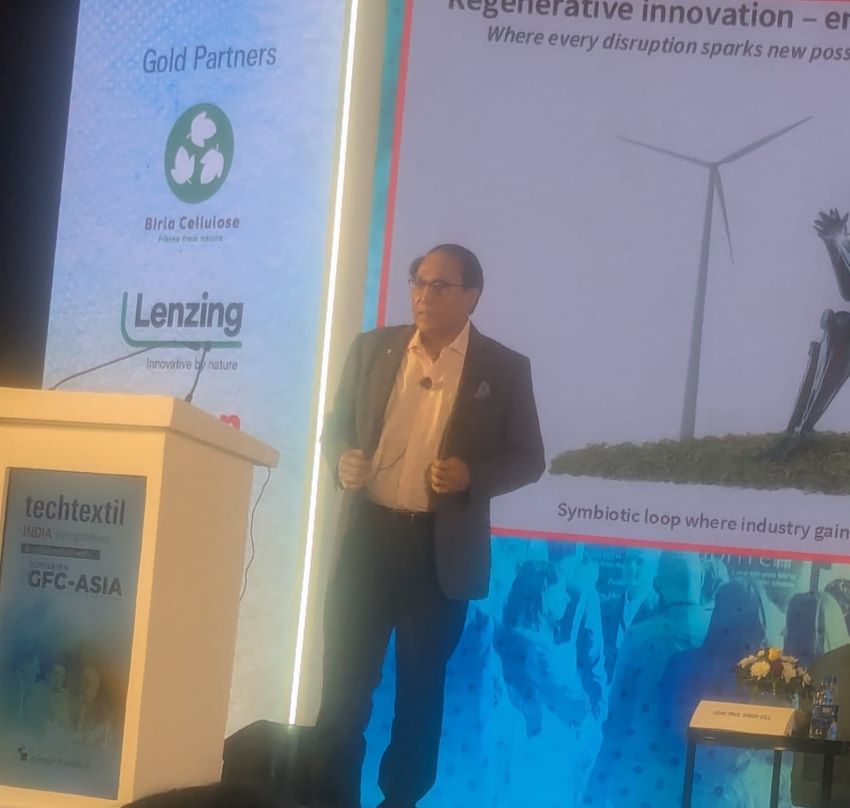FW
Not too long ago, cashmere was considered a rare luxury— made from the finest wools from traditional mills in Europe. As cashmere became wildly popular, suppliers started increasing production which meant raising many more goats on fragile Mongolian grasslands. However, this led to desertification and an environmental disaster in these grasslands as the sharp hooves of the goats destroyed the topsoil.
Quality also suffered as cut-price cashmere products (this is essentially a contradiction in terms as cashmere was never meant to be cheap or cut-price) flooded the market. The cheap cashmere revolution started in 2005 when import quotas were relaxed and China started exporting huge volumes of it to the EU. The lower end of the market still tends to be dominated by fibers from Chinese goats.
A fter washing, the finest, softest hair is separated from the coarser, outer guard hair. This guard hair is not considered high enough quality for many top-end manufacturers, but it is this level of quality customers will buy as cut-price cashmere. Alpaca is fast emerging as an alternative to the overexploitation of environmentally fragile grasslands in Mongolia. Alpaca comes from the South American highlands and Andes in Bolivia, Argentina but mainly Peru.
Many brands including Gucci are now offering alpaca accessories and garments. Alpaca is as luxurious and light to the feel as cashmere but its environmental impact is far less as the alpacas do not destroy the topsoil where they graze.
"Every year, 80 billion garments are made globally generating 1.3 billion tons of fabric waste, says Mausmi Ambastha, Founder and COO, Threadsol. In her recent blog ‘You Waste 1.3 Billion Tonnes Of Fabric. What Are You Doing About It?’ Ambastha urges apparel manufacturers to look into the harmful impact on environment of the fabric wasted during manufacturing process and invest in greener technologies to make manufacturing environmentally sustainable. Indeed, environment issues are high on the agenda everywhere with air pollution, noise pollution, wastes from plastic, food and materials from our everyday lives being monitored."

Every year, 80 billion garments are made globally generating 1.3 billion tons of fabric waste, says Mausmi Ambastha, Founder and COO, Threadsol. In her recent blog ‘You Waste 1.3 Billion Tonnes Of Fabric. What Are You Doing About It?’ Ambastha urges apparel manufacturers to look into the harmful impact on environment of the fabric wasted during manufacturing process and invest in greener technologies to make manufacturing environmentally sustainable. Indeed, environment issues are high on the agenda everywhere with air pollution, noise pollution, wastes from plastic, food and materials from our everyday lives being monitored. But the fact is nearly 75 per cent of global fabric waste is discarded untreated and this waste either end up in landfills or is burnt thereby polluting water and land alike, she argues.
More fiber, more waste, more damage

Global supply of fibers has almost double in the last decade from 52.6 million tons to 100 million tons. More production means more waste, leading to a negative impact on the environment. Ambastha writes, textile wastes comprise 1.0 – 5.1 per cent of Municipal Solid Waste (MSW) compositions in the world regions. Although textile and apparel manufacturing has largely shifted to developing countries, textile waste remains a big concern both in developed and developing countries. In the US this waste is 4.95 per cent , China 1.3 and in a small country like Bhutan it is as high as 4.7 per cent. The environmental issues during the operational phase of textile manufacturing include the following:
Hazardous materials
Chemicals like Benzene, Cyanide, and Sulphate are discharged as effluents in the manufacturing of textiles which pose a serious health hazard.
Waste water
She points out that the textile industry utilises various chemicals and large amount of water during the production process. “The water is mainly used for application of chemicals onto fibers and rinsing of the final products. The waste water produced during this process contains a large amount of dyes and chemicals containing traces of metals such as Cr, Cu and Zn which are capable of harming the environment and human health. The textile waste water can cause hemorrhage, ulceration of skin, nausea, skin irritation and dermatitis. The chemicals present in the water block the sunlight and increase the biological oxygen demand thereby inhibiting photosynthesis and re-oxygenation.”
Emissions to air
Some textile manufacturing operations result in significant air pollution. Finishing processes (e.g. coating and dyeing operations) are some of these. Other significant sources of air emissions include drying, printing, fabric preparation, and wastewater treatment residues. “Solvents may be emitted from coating / treatment finishing processes, drying ovens, and high-temperature drying and curing. Other potential emissions include formaldehyde, acids (especially acetic acid), and other volatile compounds, such as carriers and solvents, emitted during dyeing operations and from wastewater treatment operations. Solvent vapors may contain toxic compounds such as acetaldehyde, chlorofluorocarbons, dichlorobenzene, ethyl acetate, methylnaphthalene, chlorotoluene, among others.”
Energy consumption
Textile manufacturing also results using up of a lot of energy resources. Heat consumption is particularly significant in drying and curing operations and in activities involving wet treatments.
Solid and liquid wastes Then there are solid and liquid wastes that are left out these include trials, selvedge, trimmings, cuttings of fabrics, and yarns; spent dyes, pigments, and printing pastes; and sludge from process wastewater treatment containing mainly fibers and grease.
Steps to be taken
Ambastha says, the Americans generate nearly 13 million tons of textile waste every year, while British generate 1.12 million tons. And even though the British seem to generate less waste, one in five British are known to throw away a garment after one wear. Statistically this means $127 million of clothing in landfills every year. Also, 15 per cent of fabric for clothing ends up on the cutting floor. Then in China, millions of unused fabrics from mills are wasted every year just because the colour dyed on them was wrong. What’s more a single mill in China uses up 200 tons of water for each ton of fabric it dyes. And many rivers water run the colour of the season as effluent plants are missing. Ambastha there urges the industry to invest time and energy to be more aware of the wastage and the terrible environmental impact of manufacturing. ThreadSol too offers solutions like intelloBuy and intelloCut to reduce fabric wastage in factories by upto 10 per cent, thereby boosting profits by 50 per cent.
China's home-textiles export dropped remarkably by 18.1 per cent to $3.65 billion in this calendar year, says China Chamber of Commerce for Import and Export of Textile and Apparel. The reason: weak demand and high year-on-year basis compared to the over 20-per cent growth in same period of last year.
Export to the United States, Europe and Japan all saw double-digit decline. In January-February, China's export to the above-mentioned three markets presented a downward trend. The export stood at $1.02 billion, $670 million and $330 million, down 14.9 per cent, 10.9 per cent and 10.5 per cent respectively from a year earlier.
China's export of home-textiles to ASEAN markets and Latin America dropped significantly by 30.6 per cent and 40.3 per cent in the same period. While Guangdong Province remained the big player, inland provinces/municipalities have poor performance. The top five exporters are Zhejiang, Jiangsu, Shandong, Shanghai and Guangdong, but the exports from the first four declined, in which, Zhejiang, Jiangsu and Shanghai saw significant decline between 13 per cent and 22 per cent, while Shandong saw 4.8-per cent drop. Guangdong Province alone maintained steady growth despite unfavorable situation, but the growing pace slowed down to 9.4 per cent.
Exports from many inland provinces/municipalities such as Hebei, Anhui, Chongqing and Xinjiang saw over 20-per cent decline, Yunnan, Xichuan and Gansu even saw over 50-per cent decline.
The Bangladesh government has sought cooperation from the Institute of Chartered Accountants of Bangladesh (ICAB) for the implementation of 5 per cent profit sharing with the Workers Welfare Fund as per Labour Act. The meeting with the ICAB leaders held at Labour and Employment Ministry also discussed ways ICAB could help the government in implementing the Labor Act, which has a provision of 5 per cent profit sharing to the welfare funds for ensuring workers’ rights.
According to Labour Act, each company will have to pay 5 per cent of the net profit of the previous year at the proportion of 80:10:10 respectively to the Participatory Fund, Welfare Fund and Workers Welfare Foundation Fund established under a section 14 of the Bangladesh Workers Welfare Foundation Act, 2006.
If the auditors could raise questions about the law while preparing the audit report, the owners of the company will have to contribute to the fund as per the rules.
Bangladesh, India and Pakistan are expecting higher exports of readymade garment (RMG) to the United States (US) and European Union (EU) as the exports from the East Asian giant China and start-ups Cambodia and Vietnam are the on decline. The textile and apparel (readymade garments) exports from China, Vietnam and Cambodia to the US declined by 43.3 per cent, 22.4 per cent and 22 per cent respectively in March compared with February, according to the US Department of Commerce’s Office of Textiles and Apparel.
Incidentally, the decline in textile exports in March ’16 was 42.1 per cent for China, 22.6 per cent for Vietnam and 34.4 per cent for Cambodia against the same month in the last year. Meanwhile, textile and RMG exports from Bangladesh to the US recorded an increase of 7.9 per cent in March this year compared to the same month in the last year.
Whereas, textile and RMG exports from India to the US increased by 15.3 per cent in March compared with same month last year while RMG exports from Pakistan to the US increased by 8.8 per cent. However, in volume terms Bangladesh RMG exports to US continued to surpass exports from India and Pakistan.
Production of cotton in the US is anticipated to rise 15 per cent from 2015-16, based on 9.6 million planted acres as indicated in Prospective Plantings, combined with below-average abandonment, due to relatively favorable moisture, and average yields. A projected cotton crop of 14.8 million bales in 2016-17 in the US is expected to boost next season’s ending stocks, well above the beginning level. Domestic mill use is projected to be stable at 3.6 million bales, while exports are expected to rise to 10.5 million, on higher available supplies and more marketable qualities. Ending stocks are projected at 4.7 million bales, or one-third of total use. The preliminary range for the marketing year average price received by producers is 47.0 to 67.0 cents per pound.
During 2015-16, US cotton production increased marginally. Export forecast is reduced to 9.0 million bales, reflecting lower-than-anticipated export sales to date, with ending stocks raised accordingly. As per 2016-17 global cotton projections, a decline in stocks of more than 6.0 million bales is expected, as consumption exceeds production for the second consecutive season. Global production is expected to rise 5 per cent, despite marginally lower area, as yields recover from weather and pest pressures that affected crops in 2015-16. Production is forecast to rise mainly in Pakistan, United States, India, and Turkey, partially offset by a 1.3-million-bale reduction in China. Global consumption is projected to rise 1.6 per cent, as prices overall remain low and mills in China gain access to domestic cotton at more competitive prices.
Exporters in Tirupur say the proposal to fix the minimum wage for contract workers at Rs 10,000 will hurt the industry. Tirupur is the biggest knitwear hub in India and exports knitwear garments to more than 100 countries. In 2015-16, it recorded Rs 23,050 crores in exports as against Rs 21,000 crores achieved in 2014-5 and is currently providing employment to six lakh workers directly, out of which 70 per cent are women.
At the all-India level, the share of Tirupur has gone up from Rs 12,500 crores in 2011-12 to Rs 23,050 crores in 2015-16 i.e. from 19.1 per cent to 20.72 per cent. However, the sector is facing a tough proposition in the global market due to lower competitiveness in certain areas such as bank interest, infrastructure, transaction cost, and power cost including labor wages.
Competitors have forged ahead. Vietnam has already signed an FTA with EU, which will come into effect from 2017 and is one of the member countries of the Trans Pacific Partnership agreement. Likewise, being a least developed country, Bangladesh enjoys a duty free status in the EU and Canada.
India too has the potential to enhance exports to the EU. The EU accounts for a chunk of the total exports from India. Of the total exports of $17 billion, the EU accounts for $6.29 billion.
India is hopeful of signing the free trade agreement with the EU soon. This is expected to give an impetus to exports from the country. Talks have been broken for a while but now dialogues with the European Union have been revived. India is also taking steps to get the FTA with the United States ratified at the earliest.
Apparel exporters from clusters like Tirupur want FTAs with EU and the US as most of their exports are to these two regions. The country is encouraging garment exporters to explore new markets in South America and the Middle East, among other regions. Similarly, product diversification is being promoted so that apparel exporters can penetrate niche markets across the globe.
However, India’s share of apparels made of manmade fibers continues to remain low, even as 60 per cent of the shelf space in global markets is getting occupied with garments made of manmade fibers. Perhaps the use of manmade fibers is low due to the tax structure. So there has been a suggestion to reduce excise duty on manmade fibers from 12 per cent to 6 per cent.
Dalena White has been appointed the new secretary general of International Wool Textile Organisation (IWTO). She has had experience in marketing, retail and fashion and has worked as a designer and pattern maker in design studios. She knows about wool and the wool industry. She has curated exhibitions such as Design Indaba and Wool Week South Africa.
White has served as marketing consultant for Cape Wools, promoting merino wool among retailers and designers, building brand awareness and educating consumers among the unique properties of wool. She has served on the board of Sweet-Orr and Lybro, a leader in the protective clothing business, as merchandise director for men’s, women’s and children’s denim and cotton garments.
With a membership comprising 60 per cent of total wool production worldwide, encompassing the wool pipeline from sheep to shop, the IWTO represents the interests of the wool textile trade at the global level. It facilitates industry strategy and ensures standards in manufacturing and sustainability. IWTO fosters connection between members and all stakeholders through mutual support of opportunities for wool.
White was chosen through a competitive selection process from a strong set of international candidates. She will take up her role on May 17, 2016, at which time the current secretary general will step down.
Macy's same-store sales fell steeper-than-expected at 5.6 per cent in the first quarter while net sales declined 7.4 per cent. The retailer slashed its full-year forecast. The dismal forecast from the retailer pushed its shares down nearly 14 per cent to a more than four-year low.
Macy’s forecast cut reflects increased pessimism on the consumer's willingness to shop for apparel and accessories over the balance of the year. Apparel sales were also hurt by unseasonably cool weather in late March and early April, when retailers usually launch spring collections.
Macy's, profits have been shrinking for more than a year, and now it wants to intensify cost cutting and monetize unproductive real estate. About 40 per cent of Macy’s merchandise is exclusive, while the rest is available at competitors and at lower prices.
Macy's is working to boost sales by rolling out more of its backstage off-price stores and launching exclusive product ranges, including a clothing and accessories line in partnership with singers Elton John and Lady Gaga.
The intent is to bring the shopper into the store, have a product that's emotionally exciting to the consumer, a differentiated product that’s not available elsewhere.
Macy’s stock has lost 44 per cent of its value in the past 12 months.












